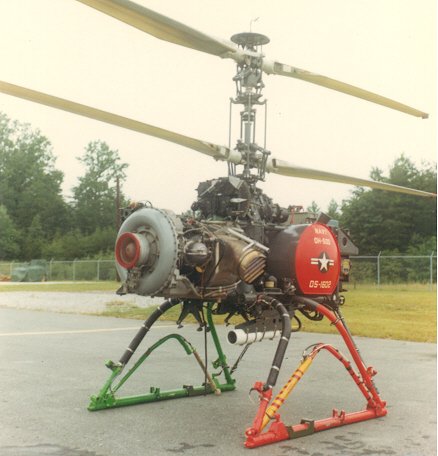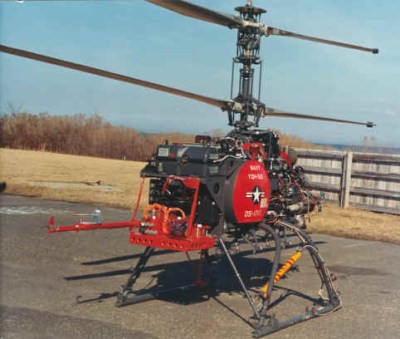Gyrodyne DSN/QH-50 DASH
The U.S. Navy's QH-50 DASH (Drone Anti-Submarine Helicopter) was the first, and so far only, operational unmanned helicopter designed for a combat role.
The DASH program had its roots in the late 1950s, when the U.S. Navy sought a way to upgrade its WW2-era destroyers to effectively counter the Soviet submarine threat. A central component of this upgrade was to be the forthcoming AN/SQS-26 ASW sonar. That sonar's detection range was promised to be much greater than the range of the forthcoming RUR-5 ASROC (Anti-Submarine Rocket), the best stand-off torpedo delivery system at that time. In April 1958, Gyrodyne received a contract to redesign its YRON-1 Rotorcycle into an unmanned torpedo-carrying helicopter which could be operated from a destroyer's deck at a range of at least 48 km (30 miles). The result was the DSN-1 vehicle, which first flew with a safety pilot on board in 1959, while the first unmanned flight succeeded in August 1960.
The DSN-1 was powered by a single Porsche YO-56-6 piston engine, which drove two coaxial rotors. It could carry one MK 43 torpedo to a range of 48 km (26 nm). The drone was controlled from the ship via radio commands transmitted over a UHF line-of-sight datalink. During the take-off and landing phases, the "pilot" stood on deck for direct visual observation of the helicopter, while for the duration of the mission, the drone was tracked by radar and steered from the destroyer's CIC (Combat Information Center). Drone control could also handed over in flight from one control ship (or ground station) to another. When the DASH drone was over the location of the target (known from sonar data), the torpedo could be armed and released by remote command.
 |
| Photo: © Gyrodyne Helicopter Historical Foundation |
| DSN-1 (QH-50A) |
The DSN-2 was similar to the DSN-1, but was powered by two YO-95-6 engines in place of the DSN-1's single one to provide a higher performance. The DSN-2 was flown in manned form only.
Only nine DSN-1 and three DSN-2 drones were built, because the Navy had decided not to put the the piston-engined versions in service. Instead, in February 1960 Gyrodyne was contracted to develop the DSN-3 turboshaft-powered derivative of the DASH drone. The reason was that the piston engines' gasoline fuel is much more dangerous to operate on ships than the kerosene of turbine engines. The DSN-3 first flew in unmanned form in January 1962, and deliveries to the U.S. Navy began in November that year.
In September 1962, the DSN-1, -2 and -3 helicopters were redesignated in the H-50 series as follows:
| Old Designation | New Designation |
|---|---|
| DSN-1 | QH-50A |
| DSN-2 | QH-50B |
| DSN-3 | QH-50C |
The QH-50C was powered by a Boeing T50-BO-8A turboshaft engine. The much higher performance of that engine compared to the YO-95 of the QH-50A/B necessitated an almost complete redesign of the transmission and rotor system, so that the QH-50C was effectively a new aircraft. It was also fitted with two small vertical tails on a framework behind the main fuselage. Combat radius of the drone was about 56 km (30 nm) and payload were either two MK 44 or a single MK 46 torpedo. Because the modification of the many WW2-era destroyers (under the FRAM (Fleet Rehabilitation and Modernization) program) to deploy the DASH system was proceeding ahead of schedule, the QH-50C's test and development program had to be extremely rushed. This meant that problems with the automatic flight stabilization and control system could not be fully solved before delivery of operational drones began, and that lead to 27 crashes during the first two months of operational deployment. However, by June 1963 the problems had essentially been solved, and Gyrodyne proceeded to build a total of 373 QH-50Cs.
 |
 | |
| Photos: © Gyrodyne Helicopter Historical Foundation | ||
| QH-50C | ||
The QH-50D, of which 370 examples were built, was an improved QH-50C. The first YQH-50D, a converted QH-50C, was first flown in April 1965, and deliveries of the production QH-50Ds began in January 1966. The QH-50D had a higher-performing T50-BO-12 engine, lighter fibreglass rotor blades with de-icing capability, improved floatation package, increased fuel capacity and provisions for easier weapon loading and aircraft maintenance. The most prominent external change was the deletion of the QH-50C's tail fin assembly. The upgrades gave the QH-50D better performance, reliability and all-weather capability. Furthermore, this version had the option to employ a MK 17 nuclear depth charge with a 10 kT W-44 warhead (the same as in the nuclear variant of ASROC).
 |
| Photo: © Gyrodyne Helicopter Historical Foundation |
| QH-50D |
In April 1968, Boeing ceased production of the T50 engine, and Gyrodyne searched for alternative powerplants for the QH-50 helicopter. The selection fell on the Allison T63, and three QH-50Ds were modified to YQH-50E configuration with a T63-A-5A engine. The YQH-50E flew for the first time in unmanned configuration in September 1969. The designation QH-50F applied to the proposed production version of the YQH-50E with a higher-rated T63 engine, but no -50F was built. Finally, the unbuilt QH-50H (there are no records of a -50G designation) was a projected twin-engined QH-50F with two T63s and larger fuselage (with a length of 5.27 m (17 ft 3.5 in)) and rotors (with 8.53 m (28 ft) diameter).
 |
| Photo: © Gyrodyne Helicopter Historical Foundation |
| YQH-50E |
The DASH program never lived up to the expectations. First there were problems with the drones because of the hurried development. Later, inadequate training of the DASH personnel led to inefficient use of the system. Furthermore, the AN/SQS-26 sonar took much longer to develop than expected, and in the end it was never installed in many of the FRAM destroyers which were using DASH. This led to an end of QH-50 production in 1969, and in 1970 the whole DASH program was cancelled altogether. The remaining QH-50C/D drones were put in storage.
 |
| Photo: © Gyrodyne Helicopter Historical Foundation |
| QH-50D |
In addition to their ASW role, the QH-50s were used and tested with several other types of payload. Under project SNOOPY, the Navy fitted QH-50C and D drones with a TV camera and real-time datalink, and used them for surveillance and target spotting over the coast of Vietnam. DARPA's NITE PANTHER program modified several QH-50Ds as day/night surveillance and targeting platform using a variety of sensor systems and target designators. A similar program was NITE GAZELLE, where QH-50Ds were modified as armed UAVs. The tested armament included a minigun, grenade launcher, bombs, bomblet dispensers and Martin Marietta LARS (Laser-Aided Rocket System) air-to-ground missiles.
By 1974, the use of the QH-50 for operational or research purposes had ceased. The remaining QH-50C/D aircraft were used as target drones on White Sands Missile Range (WSMR) for surface-to-air and air-to-air missile training. By 1986 the number of drones had shrunk significantly, and the Navy actually thought about procuring a small batch of new-built QH-50s. However, this idea was turned down because of the costs, and the QH-50s were subsequently modified to carry tow targets so that the drone itself would only seldom be shot down. The QH-50D target-towing drones are currently under the control of the U.S. Army's Program Executive Office for Simulation, Training & Instrumentation (PEO-STRI), and about 25 of the aircraft are still in use at WSMR.
Specifications
Note: Data given by several sources show slight variations. Figures given below may therefore be inaccurate!
Data for QH-50A/C/D:
| QH-50A | QH-50C | QH-50D | |
|---|---|---|---|
| Length (w/o rotor) | 1.96 m (6 ft 5 in) | 3.94 m (12 ft 11 in) | 2.33 m (7 ft 7.6 in) |
| Width (w/o rotor) | 1.70 m (5 ft 7 in) | 1.60 m (5 ft 3 in) | |
| Rotor diameter | 6.10 m (20 ft 0 in) | ||
| Height | 2.39 m (7 ft 10 in) | 2.96 m (9 ft 8.5 in) | |
| Weight (ASW role) | 400 kg (885 lb) | 1030 kg (2280 lb) | 1060 kg (2330 lb) |
| Speed | 107 km/h (67 mph) | 148 km/h (92 mph) | |
| Ceiling | ? | 4940 m (16200 ft) | 4790 m (15700 ft) |
| Mission radius | 48 km (26 nm) | 52 km (28 nm) | 74 km (40 nm) |
| Propulsion | Porsche YO-95-6 piston engine; 54 kW (72 hp) |
Boeing T50-BO-8A turboshaft; 224 kW (300 shp) |
Boeing T50-BO-12 turboshaft; 272 kW (365 shp) |
Main Sources
[1] Kenneth Munson: "World Unmanned Aircraft", Jane's, 1988
[2] Norman Friedman: "US Naval Weapons", Conway Maritime Press, 1983
[3] Gyrodyne Helicopter Historical Foundation Website
Back to Directory of U.S. Military Rockets and Missiles, Appendix 4
Last Updated: 28 April 2004